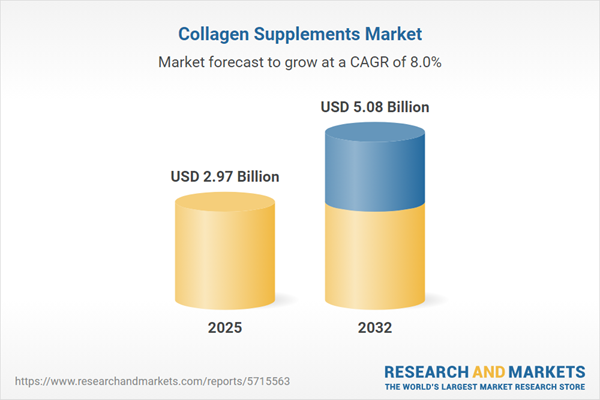Speak directly to the analyst to clarify any post sales queries you may have.
Senior leaders in the collagen supplements market face a rapidly changing environment shaped by dynamic consumer behaviors, rising regulatory pressures, and continual supply chain adaptation. Real-time market intelligence and the capacity to swiftly recalibrate strategies are crucial for businesses seeking sustainable growth and secure positioning in this evolving sector.
Market Snapshot: Collagen Supplements Market Size and Growth
The collagen supplements market is demonstrating strong international expansion, driven by rising demand for holistic wellness across both enterprise buyers and individual consumers. This growth is supported by a diverse range of sales pathways, including retail, B2B, and direct-to-consumer models, all experiencing increased activity. To capture this momentum, companies are investing in agile product development—accelerating time-to-market with advanced delivery technologies and continuously refining product offerings. Emphasis on supply chain resilience, robust procurement solutions, and regulatory compliance has become essential, enabling businesses to maintain their competitive edge and ensure uninterrupted operations as market complexities deepen.
Scope & Segmentation: Collagen Supplements Market Analysis
This report delivers targeted insights to senior executives, highlighting operational and strategic dimensions that influence market leadership:
- Forms: Capsules, gummies, liquids, and powders provide entry points for brands to address varied dosing requirements, enable differentiated product launches, and attract consumers in new sub-segments.
- Sources: Bovine, marine, plant-based, and porcine options expand the palette of ingredient sourcing, supporting sustainability drives and presenting avenues to overcome supply chain reliability challenges.
- Types: Gelatin, hydrolyzed collagen, and native collagen offer diversified applications, serving both general wellness users and specialized sectors such as clinical nutrition and healthcare.
- Applications: Beauty, clinical nutrition, joint health, and sports recovery remain central demand drivers, informing business strategies catering to institutional buyers and attentive, health-motivated end users.
- Channels: Direct-to-consumer ecommerce, wellness-focused retail, pharmacies, specialty outlets, and wholesale distribution collectively extend B2B and B2C market accessibility.
- End Users: Healthcare professionals, sports organizations, wellness groups, and informed, proactive consumers all have discernible influence on the procurement and selection process, fueling sector diversity.
- Regions: With the Americas, Europe, Middle East & Africa, and Asia-Pacific representing distinctive growth arenas, adoption of tailored regional distribution strategies and rigorous compliance sets the bar for optimized market entry.
- Key Companies: Major participants such as Gelita AG, Darling Ingredients Inc., Nitta Gelatin Co., Ltd., Weishardt Group SAS, International Flavors & Fragrances Inc., Nestlé Health Science SA, Kewpie Corporation, Nippi, Inc., Collagen Solutions Limited, and Lapi Gelatine S.p.A. sustain their roles through continual technology advancement and robust global supply chains.
Key Takeaways for Senior Decision-Makers
- Diversifying product portfolios with capsules, liquids, and gummies enables brands to unlock new customer segments and address evolving distribution strategies.
- Adopting marine and plant-based collagens aligns sourcing operations with organizational sustainability mandates and fortifies long-term supply chain reliability, especially across global regions.
- Utilizing advanced production processes in hydrolyzed collagen enhances positioning within higher-margin categories, such as beauty and active lifestyle products, meeting user expectations for performance and efficacy.
- Forging strategic partnerships with healthcare and wellness entities strengthens credibility, and data-driven marketing campaigns provide measurable returns in brand equity and stakeholder engagement.
- Prioritizing transparency and end-to-end traceability in procurement boosts risk mitigation and helps organizations adapt as compliance requirements change.
- Implementing multi-channel sales solutions, including integrated digital and traditional methods, maximizes reach and operational resilience through shifting market landscapes.
Tariff Impact: Navigating the 2025 Trade Landscape
Anticipated US tariffs on bovine and marine collagen in 2025 are prompting immediate adjustments to supply chain strategies. Organizations are responding by enhancing supplier relationships, exploring alternative sourcing, and strengthening compliance protocols to secure continued market access. These proactive measures enable companies to manage emerging trade disruptions and safeguard operational continuity.
Methodology & Data Sources
This report draws from executive-level interviews, analysis by experts in dermatology and sports nutrition, and systematic reviews of current literature and patents. The research approach ensures findings are reliable, nuanced, and applicable to the decision-making needs of B2B leadership teams.
Why This Collagen Supplements Market Report Matters
- Empowers executives to craft responsive market strategies, strengthen compliance processes, and rapidly adjust as sector conditions shift.
- Supports procurement optimization and supply diversification, enhancing adaptability and minimizing exposure to volatility.
- Offers actionable competitive intelligence on technology and product trends, guiding investments and long-term planning.
Conclusion
This report enables senior leaders to support informed growth initiatives, nurture innovation, and build organizational resilience in the advancing collagen supplements market.
Additional Product Information:
- Purchase of this report includes 1 year online access with quarterly updates.
- This report can be updated on request. Please contact our Customer Experience team using the Ask a Question widget on our website.
Table of Contents
3. Executive Summary
4. Market Overview
7. Cumulative Impact of Artificial Intelligence 2025
Companies Mentioned
The companies profiled in this Collagen Supplements market report include:- Gelita AG
- Darling Ingredients Inc.
- Nitta Gelatin Co., Ltd.
- Weishardt Group SAS
- International Flavors & Fragrances Inc.
- Nestlé Health Science SA
- Kewpie Corporation
- Nippi, Inc.
- Collagen Solutions Limited
- Lapi Gelatine S.p.A.
Table Information
| Report Attribute | Details |
|---|---|
| No. of Pages | 190 |
| Published | October 2025 |
| Forecast Period | 2025 - 2032 |
| Estimated Market Value ( USD | $ 2.97 Billion |
| Forecasted Market Value ( USD | $ 5.08 Billion |
| Compound Annual Growth Rate | 7.9% |
| Regions Covered | Global |
| No. of Companies Mentioned | 11 |









